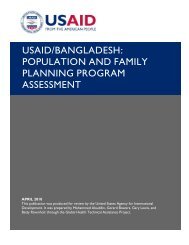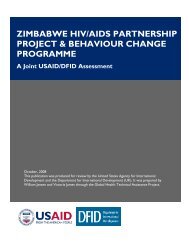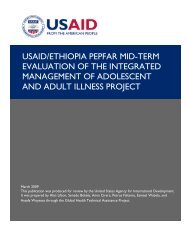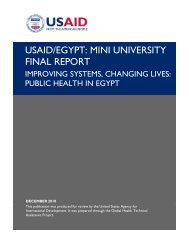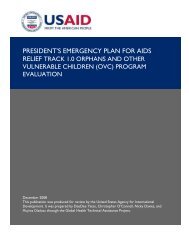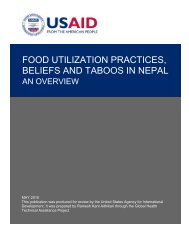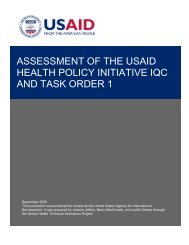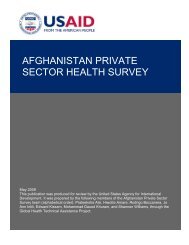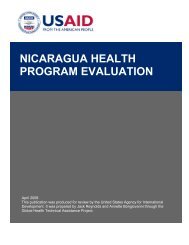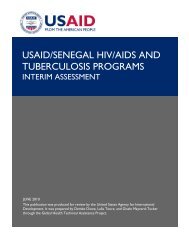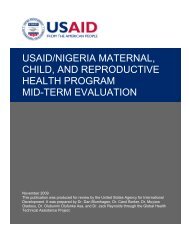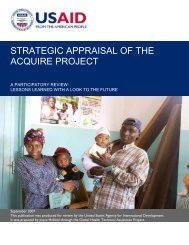Evaluation of the Tuberculosis Control Assistance Program (TB CAP)
Evaluation of the Tuberculosis Control Assistance Program (TB CAP)
Evaluation of the Tuberculosis Control Assistance Program (TB CAP)
You also want an ePaper? Increase the reach of your titles
YUMPU automatically turns print PDFs into web optimized ePapers that Google loves.
(CTO) resides in GH/HIDN in Washington, DC. Along with <strong>the</strong> Contracting Agreement Officer, <strong>the</strong> CTOis ultimately responsible for ensuring that <strong>the</strong> project strategic approach, timeliness <strong>of</strong> products, financialmanagement and cost control, quality <strong>of</strong> products, and reported results are according to <strong>the</strong> overallcooperative agreement and approved work plans.<strong>TB</strong> <strong>CAP</strong> is executed by a consortium <strong>of</strong> seven organizations, which collectively refer to <strong>the</strong>mselves as <strong>the</strong><strong>Tuberculosis</strong> Coalition for Technical <strong>Assistance</strong> (<strong>TB</strong>CTA). 8 The prime organization is <strong>the</strong> KNCV<strong>Tuberculosis</strong> Foundation (KNCV) and <strong>the</strong> six sub-grantees are <strong>the</strong> American Thoracic Society (ATS),Family Health International (FHI), International Union Against <strong>Tuberculosis</strong> and Lung Disease (<strong>the</strong>Union), Japan Anti-<strong>Tuberculosis</strong> Association (JATA), Management Sciences for Health (MSH), and <strong>the</strong>World Health Organization (WHO). The Centers for Disease <strong>Control</strong> (CDC) is a coordinating member <strong>of</strong><strong>the</strong> Coalition but funds for this agreement do not flow to or through CDC. The organizations that form <strong>the</strong>partnership are described below:1. KNCV, based in <strong>the</strong> Ne<strong>the</strong>rlands, is a medical development organization that focuses on combating<strong>TB</strong> globally. Its mission is to promote effective and efficient <strong>TB</strong> control in both a national and aninternational context. It has been working in <strong>TB</strong> control for over 100 years and in <strong>the</strong> 1980s begancontributing to <strong>the</strong> development and implementation <strong>of</strong> effective <strong>TB</strong> control programs in low-incomecountries. It also hosts <strong>the</strong> International <strong>Tuberculosis</strong> Surveillance Centre (ITSC) and <strong>the</strong><strong>Tuberculosis</strong> Surveillance Research Unit (TSRU); contributes to international policy developmentespecially within its collaboration with WHO and <strong>the</strong> <strong>the</strong> Union; and collaborates with numerousinternational organizations. It is <strong>the</strong> prime organization for this cooperative agreement andresponsible for administrative management.2. ATS, with headquarters in New York City, is a non-pr<strong>of</strong>it educational and scientific society and is <strong>the</strong>major medical pr<strong>of</strong>essional and scientific organization with an interest in <strong>TB</strong>. The ATS hasconsiderable experience in collaborating with <strong>the</strong> CDC and Infectious Disease Society <strong>of</strong> America indeveloping guidelines for <strong>TB</strong> prevention and control used both in <strong>the</strong> United States and in o<strong>the</strong>r parts<strong>of</strong> <strong>the</strong> world. The ATS publishes a highly respected and widely read scientific journal. In addition, <strong>the</strong>Society conducts an annual international conference that attracts 15,000-16,000 attendees and is amajor forum for <strong>the</strong> presentation <strong>of</strong> new information about <strong>TB</strong> and its control as well as providing anarena for <strong>TB</strong> training and education. A broad range <strong>of</strong> specific technical expertise is represented in<strong>the</strong> organization.3. FHI is a nongovernmental, nonpr<strong>of</strong>it organization dedicated to improving lives and increasingknowledge worldwide through research, education, and services. FHI has implemented programs in66 countries and has worked on HIV/AIDS in <strong>the</strong> developing world since 1986. FHI advocates forgreater coordination <strong>of</strong> HIV and <strong>TB</strong> programs and provides technical expertise in increasing <strong>TB</strong>patient access to HIV prevention and voluntary counseling and testing (VCT), integrating <strong>TB</strong>preventive <strong>the</strong>rapy into services for HIV positive patients and VCT, and intensified case finding <strong>of</strong><strong>TB</strong> cases among partners <strong>of</strong> HIV-infected <strong>TB</strong> patients.4. The Union, an NGO headquartered in Paris, is comprised <strong>of</strong> constituent, organizational, andindividual members. There are Union regional organizations in North America, Latin America,Europe, Africa, Asia, and <strong>the</strong> Middle East. The Union disseminates information on <strong>TB</strong>, lung disease,and tobacco, coordinates and assists <strong>the</strong> work <strong>of</strong> its members throughout <strong>the</strong> world, and maintainsclose links with WHO, o<strong>the</strong>r UN agencies, and government and nongovernment organizations in <strong>the</strong>8 <strong>TB</strong>CTA was created in 2000 when a group <strong>of</strong> international <strong>TB</strong> partners came toge<strong>the</strong>r to develop an unsolicitedproposal to USAID. The original partners were <strong>the</strong> American Lung Association (ALA), ATS, The Union, KNCV,WHO and CDC. More information can be found at www.tbcta.org.40 EVALUATION OF THE TUBERCULOSIS CONTROL ASSISTANCE PROGRAM (<strong>TB</strong> <strong>CAP</strong>)



